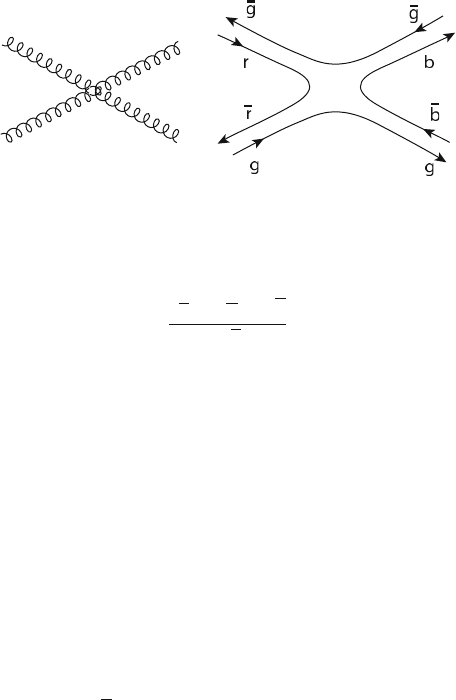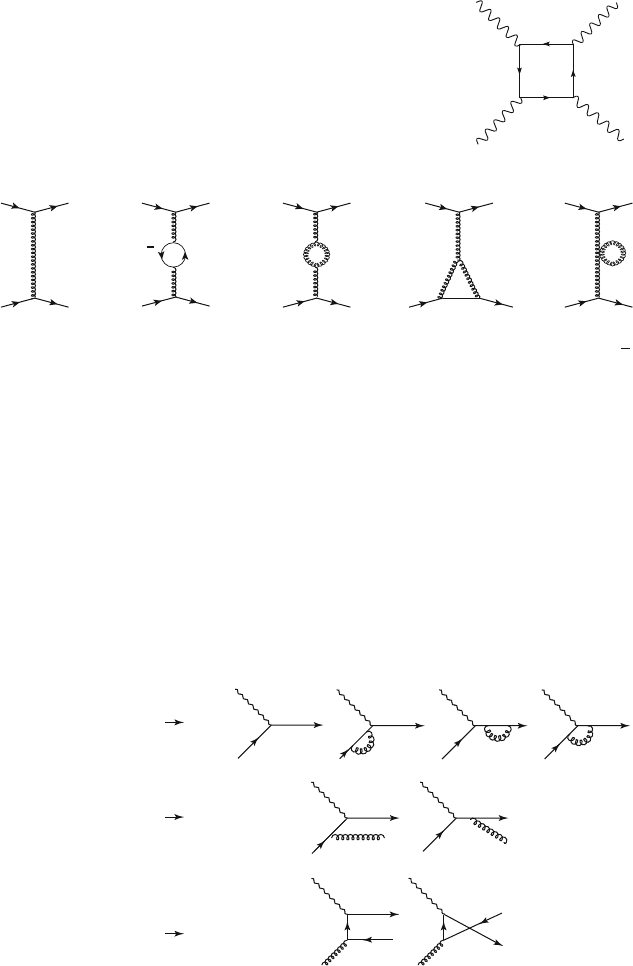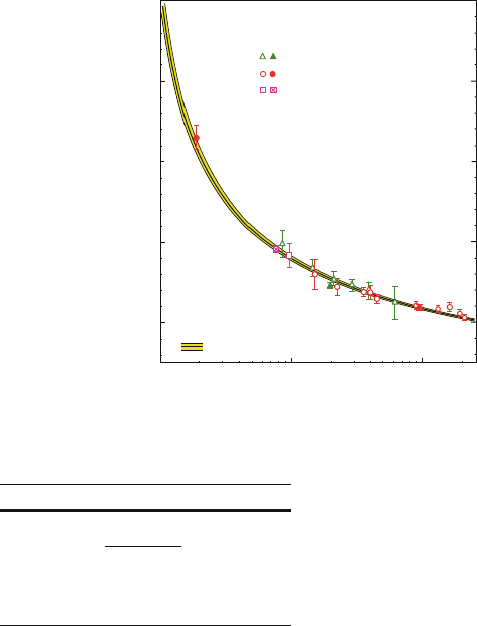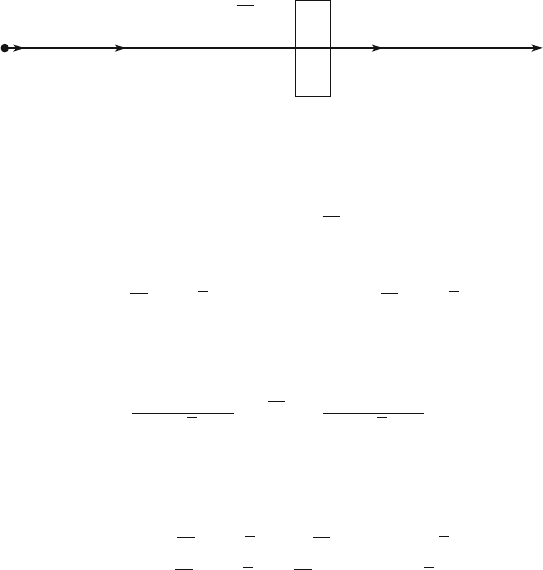Braibant S., Giacomelli G., Spurio M. Particles and Fundamental Interactions: An Introduction to Particle Physics
Подождите немного. Документ загружается.


340 11 The Standard Model of the Microcosm
a
b
Fig. 11.12 (a)Vertexgggg and (b) illustration in terms of lines of color
With three colors and three anticolors, one can form a color octet plus a color
singlet. The color singlet
r
r C gg C bb
p
3
(11.89)
does not carry color and cannot mediate an interaction between color charges. This
interaction can only be mediated by the remaining 8 gluons of the octet.
As previously said, the color charge for the strong interaction is the analogue
of the electric charge for the electromagnetic interaction. Both forces are mediated
by massless vector bosons (photon or gluons); however, for the electromagnetic
interaction, there are 2 1 charge types (positive and negative) and one neutral
mediator boson (the photon), and in QCD, there are 2 3 charge types (three colors
and three anticolors) and 8 colored mediator bosons (with color and anticolor).
These considerations lead to significant differences between QCD and QED.
A fundamental difference between QED and QCD is due to the fact that gluons
carry color and anticolor charges: they can thus interact with each other. In addition
to the vertex qqg, there is a vertex ggg as shown in Fig. 5.3. The vertex gggg
(see Fig. 11.12a, b) is also foreseen. These vertices make QCD richer than QED and
allow for the possibility of hadronic states formed only by gluons (the glueballs)and
of hybrid states such as q
qg. However, they also make QCD mathematically more
complex. Note that in QED, “photon-photon” interactions are not directly possible,
but only through pairs of electric charges, as shown, for example, in the diagram of
Fig. 11.13.
In addition to cases similar to QED (e.g., the repulsive force between two quarks
of the same color and the attractive force between quarks with color and anticolor),
in QCD, different colors may give rise to an attractive force if the quantum state
is antisymmetric, and a repulsive force if it is symmetric under the interchange of
quarks. This means that the favorite state of three quarks is the state with three
quarks of different colors, q
r
q
b
q
g
, that is, the colorless state of baryons.
At small distances (corresponding to large momentum transfers, i.e., at high Q
2
),
˛
S
is small enough to allow perturbative methods of calculation in analogy with
QED. However, at large distances (low Q
2
), one has ˛
S
1 and perturbative
methods (and first order Feynman diagrams) can no longer be used to make
calculations. The hadron masses and most of the hadronic processes at low Q
2
cannot be simply derived from QCD.

11.9 The Strong Interaction 341
Fig. 11.13 interaction
through a charged fermion
box
γ
γ
γ
γ
e
qq
qq
q
qq
qq
qq qq qq
qq qqqq
q
q
abc de
Fig. 11.14 Modifications to the simplest gluon propagator (a). In (b), one has a fermion loop (qq)
as in QED. In (c), (d), and (e), the boson contributions not present in QED are shown
11.9.2 Color Charge Screening in QCD
In QCD, the color charge screening is similar to that of an electric charge in
QED. However, besides fermionic loops, there are also bosonic loops producing
an “antiscreening” which dominates the situation (see Fig. 11.14).
It follows that ˛
S
is a “running coupling constant” [11W04]. At the lowest
order of perturbative QCD (i.e., first order in ˛
S
), the structure functions receive
contributions from the following elementary processes (V
is a virtual boson,
; Z
0
;W
˙
):
V*
V*q q
V*
q
q
q
++
+
+
g
V*q qg
V*g qq
–
q
–
Elastic scattering
QCD Compton
Boson-gluon fusion
+
Several parameterizations of ˛
S
as a function of Q
2
are possible, but all depend
on a free parameter to be determined experimentally since it cannot be predicted by

342 11 The Standard Model of the Microcosm
the theory (as the mass and electric charge of the electron in QED). In the version
in which the free parameter (dimensionally, an energy in the natural unit system) is
called
QCD
, one has
˛
S
.Q
2
/ D
12
.11N
c
2N
f
/ ln
Q
2
2
QCD
(11.90)
with N
c
D number of colors D 3andN
f
D number of kinematically accessible
flavors (for example, N
f
D 5 at Q
2
D m
2
Z
since the top quark mass is larger than
the Z
0
boson mass). From measurements (see Sect. 11.9.4), it results that
QCD
'
200 MeV and ˛
S
decreases with increasing Q
2
. While it has a value 10 (1) for
energies of the order of 100 (1,000) MeV, one has ˛
S
.m
/ ' 0:36, ˛
S
.m
Z
/ ' 0:12
(Fig. 11.15). In the limit Q
2
!1, one has ˛
S
! 0, that is, the so-called asymptotic
freedom which consists of a fundamental proof regarding the non-abelian nature of
QCD (due to the interaction terms between gluons).
The increase in effective color charge with the separation distance between
quarks can be considered as an effect due to the vacuum. It could be the cause of the
confinement of quarks and gluons in hadrons. For r 10
13
cm, the attractive force
between two quarks is large and roughly constant with r (a situation similar to that
in electromagnetism between the two plates of a capacitor). This is called infrared
slavery.
Due to the antiscreening effect, the vacuum around an isolated color charge is
unstable. This may result in the hadronization phenomenon, i.e, the transformation
of quarks in hadrons. However, the confinement is still not understood at the
fundamental level and the existence of free quarks is not fully excluded. Note that
in conditions of high energy and high density, the deconfinement phase with the
formation of a quark-gluon plasma should take place.
11.9.3 Color Factors
In QED, the electromagnetic coupling “force” between two quarks of electric
charge e
1
, e
2
is equal to e
1
e
2
˛ (e
1
;e
2
DC2=3 or 1=3). Similarly, in QCD, the
strong coupling “force” between two color charges via the exchange of a gluon is
1
2
jc
1
c
2
j˛
S
D C
F
˛
S
,whereC
F
is the so-called color factor.
The color factor for the interaction between two blue quarks can be calculated
as follows, see (11.88): only gluons that contain the color term b
b, i.e., only .rr C
g
g 2bb/
p
6, have to be taken into consideration. In this case, one has c
1
c
2
D
2
p
6
2
p
6
D
4
6
D
2
3
. Therefore, the color factor is C
F
D
1
2
jc
1
c
2
jD
1
2
2
3
D
1
3
.
By analyzing all other possibilities, it is found that for two quarks of the same color
(or of different color), c
1
c
2
D P
1
3
, with P D˙1 depending on whether the two
quarks are in a symmetric or antisymmetric color state.

11.10 The Standard Model: A Summary 343
In a baryon, the interaction between each quark pair concerns antisymmetric
states because it is necessary to have an antisymmetric final state. Therefore, for
each pair, one has c
1
c
2
D
4
3
and thus C
F
D
2
3
.
For a b
b meson changing into rr or gg, the color factor is C
F
D
1
2
. For a meson
which exchanges a gluon in a singlet state, the color factor is instead C
F
D
4
3
.In
conclusion, the general rule is
for q
qW ˛
S
is replaced by
4
3
˛
S
for qqqW ˛
S
is replaced by
2
3
˛
S
:
11.9.4 The Strong Coupling Constant ˛
S
The strong coupling constant, ˛
S
, as the fine structure constant and the universal
Fermi constant, is a free parameter of the theoretical model and must be experi-
mentally determined. QCD predicts a well-defined dependence of ˛
S
on the on the
energy scale Q of the interaction, and makes predictions about various phenomena
that allow one to determine its value. Experimental methods which measure ˛
S
and
verify the QCD predictions are (the value of Q corresponding to the process is also
indicated):
• Hadronic decays of the lepton: !
C hadrons (Q D1.77 GeV)
• Evolution of the nucleon structure functions measured in inelastic scattering of
e; ; on nucleons (Q D2 50 GeV)
• Jet production in the inelastic scattering ep ! eX (Q D2 50 GeV)
• Analyses of the energy levels of bound states q
q (quarkonium) (Q D1:55 GeV)
• Decays of the vector mesons (Q D5GeV)
• Hadronic cross-section of the annihilation e
C
e
! hadrons (Q D10200 GeV)
• Fragmentation function of jets produced in e
C
e
! hadrons (Q D10
200 GeV)
• Hadronic decays of the Z
0
boson (Q D91 GeV)
• Jet production in pp; p
p interactions (Q D50 300 GeV)
• Photon production in pp; p
p interactions (Q D30 150 GeV)
The results for some of these processes are illustrated in Fig. 11.15,whichshows
that the “constant” ˛
S
decreases with increasing of the energy scale Q.
11.10 The Standard Model: A Summary
Let us summarize the main points of the Standard Model (SM) of the micro-
cosm. It includes the electroweak interaction described by the symmetry group
[SU(2)
L
SU(1)
Y
] and the strong interaction described by the symmetry group
SU(3)
C
.

344 11 The Standard Model of the Microcosm
Fig. 11.15 Strong coupling
“constant” ˛
s
as a function of
the centre–of–mass energy.
Thelineshowsafittothe
experimental data [P08]
QCD α
s
(Μ
Z
) = 0.1184±0.0007
0.1
0.2
0.3
0.4
0.5
α
s
(Q)
1 100
Q [GeV]
Heavy Quarkonia
e
+
e
–
Annihilation
Deep Inelastic Scattering
July 2009
10
Table 11.4 Couplings in the Standard
Model
Vertex Coupling proportional to:
f
N
fe
Q
f
Zf
N
f
e
2 cos
w
sin
w
.v
f
a
f
5
/
Hf
N
fm
f
=v
HZ
0
Z
0
m
2
Z
=v
HW
C
W
2m
2
W
=v
The couplings of the vector boson Z
0
to fermions and the couplings of the
scalar Higgs boson H
0
to the W
˙
and Z
0
vector bosons are listed in Table 11.4.
Electroweak and strong interactions have a similar structure and are mediated via
the vector bosons shown in Table 11.5. The strong interaction mediators, the gluons,
carry a color charge and an anticolor charge and can interact between them, giving
rise to the ggg and gggg vertices. The mediator of the weak interaction, the vector
bosons Z
0
and W
˙
, carry a weak charge and can also interact between themselves
(vertex Z
0
W
C
W
). The gravitational interaction is not included in the SM.
The electromagnetic and weak interactions are interpreted as two different as-
pects of a unified theory describing the electroweak interaction. The electromagnetic
and weak charges are related via the Weinberg angle.
The range of the electromagnetic interaction is infinite because the photon is
massless. The range of the weak interaction at low energies is about 10
3
fm
D 10
16
cm because of the large mass of the mediator bosons W
˙
;Z
0
.The
mediators of the strong interaction, the gluons, are also massless. However, the range
of the strong force is limited to about 1 fm because of the strong interaction between

11.10 The Standard Model: A Summary 345
Table 11.5 The three fundamental interactions of the SM of the
microcosm have couplings through different charge types and are
mediated by vector bosons .J D 1/ which are massless or have
a mass around 100 GeV; the parity P is conserved in two of the
three interactions
Exchanged Mass
Interaction Coupling with bosons (GeV/c
2
) J
P
EM Electric charge Photon . / 0 1
Weak Weak charge W
˙
;Z
0
10
2
1
Strong Color charge 8 gluons .g/ 0 1
Table 11.6 In the SM, the fundamental fermions are leptons and quarks with spin 1/2; they are
grouped into three “families” (three “generations”). Quarks have a fractional electric charge and
red, blue or yellow color charge. There are no right-handed neutrinos. The right-handed quarks
and charged leptons have I
W
D 0
Family Weak isospin
Fermions 1 2 3 Electric charge Color Left-handed Right-handed Spin
Leptons
e
0 1/2 1/2
e1 1/2 0 1/2
Quarks u ctC2=3 r;b;g 1/2 0 1/2
ds b1=3 r; b; g 1/2 0 1/2
gluons. This interaction is responsible for the confinement of quarks and gluons in
hadrons, and for the nonexistence of free quarks and gluons.
The fundamental fermions are the quarks and leptons, as shown in Table 11.1.
They have spin 1/2 and are grouped in three families (generations), as illustrated
in Table 11.6. Remember that each fermion has a corresponding antifermion
as mentioned in the introduction of this chapter. On the basis of the precision
measurements of the Z
0
width, one can conclude that there are only three families
of massless (or light) neutrinos. The strong isospin is only important for the strong
interaction; for the strong isospin, the six different quark flavors form a doublet
(I D 1=2, quarks u;d) and four singlets (I D 0, quarks s; c; b; t).
The Standard Model has received strong experimental confirmation. However, an
essential element of the SM, the Higgs boson .H
0
/, has not yet been observed. The
search is now started at the LHC, see Sect. 10.10. Precision measurements in e
C
e
collisions at
p
s m
Z
constrain the H
0
mass to a relatively low value. There are
many unanswered questions surrounding the Standard Model: (1) There is a large
number of free parameters (about 18, depending on how they are counted; they are
the fundamental fermion and boson masses, the coupling constants g; g
0
;˛
S
,the
coefficients of the CKM matrix; these parameters are not given in the SM and must
be measured experimentally). (2) Why are there exactly three families of fermions?
(3) How can the neutrino masses be introduced? (4) Does the Higgs boson really
exist? (5) In vacuum, the Higgs field acquires a nonzero value (11.60) that permeates
the whole space. Does it affect the energy density of the universe?

Chapter 12
CP-Violation and Particle Oscillations
12.1 The Matter-Antimatter Asymmetry Problem
The CP transformation combines the charge conjugation C and parity P operators
(Sect. 6.8). Under CP, a left-handed electron (e
L
) becomes a right-handed positron
(e
C
R
). If CP is an exact symmetry, the laws of nature would be completely identical
for matter and antimatter. Most of the observed phenomena are symmetric with
respect to C and P , and consequently symmetric to CP. Exceptions are the weak
interactions (WI), which violate C and P maximally.ThismeansthataW boson
couples with a left-handed electron e
L
, but not with the particle P -conjugated (e
R
)
or C -conjugated (e
C
L
). However, the same boson couples with the CP-conjugated
particle, the e
C
R
. This seems to suggest that the weak interaction preserves CP.On
the contrary, it has been known for many years that the CP symmetry is violated in
some rare processes, as found for neutral K in 1964. In particular, the K
0
L
meson
decays more often in the
e
C
e
channel than in the
C
e
e
, with a very small
asymmetry of about 0.3%. Recently, a similar effect was found for beauty mesons
with a larger asymmetry.
Closely linked to CP is the time reversal transformation T :theCPT transfor-
mation is a fundamental symmetry of physical laws. The violation of symmetry T
is also observed in the decay of neutral K. Within the Standard Model (Chap. 11),
the CP symmetry violation is introduced through complex phases. In particular, a
simple phase factor appears in the 3 3 CKM (Sect. 8.14.3) unitary matrix that
describes the transformation of an up-type quark into a down-type quark by the
exchange of a W vector boson.
In 1967, Sakharov realized that the CP-violation is a necessary condition for
baryogenesis (Sect. 13.6), i.e., the dynamic process generating matter-antimatter
asymmetry in the Universe. The Universe seems to be made of matter, with
almost no antimatter. This implies a particle-antiparticle asymmetry and sug-
gests that CP could not be a symmetry of all fundamental interactions. Despite
S. Braibant et al., Particles and Fundamental Interactions: An Introduction to Particle
Physics, Undergraduate Lecture Notes in Physics, DOI 10.1007/978-94-007-2464-8
12,
© Springer Science+Business Media B.V. 2012
347

348 12 CP-Violation and Particle Oscillations
the phenomenological success of the mechanism that describes the CP-violation
in the Standard Model, there are probably additional, still unknown, sources of
CP-violation that explain the matter-antimatter asymmetry in the Universe.
The recent discovery that neutrinos have small mass seems to imply that there
is a source of CP-violation in the leptonic sector in addition to the hadronic one.
The studies of neutrino oscillations could provide information on leptogenesis.The
search for new processes that would violate the CP symmetry is currently one of
the most important experimental efforts in particle physics. These studies involve
the decay of mesons, the measurement of the electric dipole moment of neutrons,
electrons and nuclei, and neutrino oscillations.
In Sects. 12.2 and 12.3, we will first describe the K
0
K
0
system followed by
the similar B
0
B
0
system (Sect. 12.5). Neutrino oscillations, namely, the possible
transformation of a neutrino of one type into another type (for example,
!
),
simultaneously violating two leptonic numbers, will be described in Sect. 12.6.
While K
0
K
0
and B
0
B
0
mixings are included in the Standard Model, the
neutrino mixings require theories with massive neutrinos that enlarge the Standard
Model in some way.
12.2 The K
0
K
0
System
The K
0
and K
0
mesons are part of the meson nonet J
P
D 0
and are
strangeness eigenstates. An important property of the two neutral mesons is that
they have different production energy thresholds. The K
0
meson can be produced
in association with the
0
hyperon in the strong interaction reaction
p !
0
K
0
: (12.1)
The threshold energy of this reaction is 0.91GeV in the c.m. The
K
0
meson can
only be produced at higher energies by (for example) the strong interaction reaction
C
p ! K
0
K
C
p (12.2)
which has an energy threshold of 1.5 GeV in the c.m. Even higher energies are
needed to produce a K
0
in combination with an antihyperon. K
0
and K
0
are
therefore distinguishable particles. It is possible to determine if a K
0
or a K
0
has
been produced by observing the associated particles. Furthermore, once produced,
it is possible to distinguish one from the other because when interacting with target
nuclei, they produce particles with opposite strangeness. Also the cross-sections are
different with .K
0
N/ < .K
0
N/ because there are much more available final
states for
K
0
interactions. For the K
0
,
K
0
p ! K
0
p; K
C
n
K
0
n ! K
0
n:

12.2 The K
0
K
0
System 349
For the K
0
,
K
0
p ! K
0
p;
C
0
;
C
˙
0
;
0
˙
C
K
0
n ! K
0
n; K
p;
0
0
;
C
˙
0
;
0
˙
C
;
˙
C
:
The
K
0
can be considered as the antiparticle of K
0
,theK
as the antiparticle of
K
C
: this is evident when the K are expressed in terms of their valence quarks and
antiquarks, that is, K
C
D us, K
D us; K
0
D d s; K
0
D ds. K
0
and K
0
are
strangeness eigenstates.
The two neutral K mesons are observed to decay by WI into or in
states, following the same rules observed for other meson and baryon decays. The
decay into two pions in the final state has a lifetime much shorter than that with
three pions in the final state.
We know that the same particle cannot decay into either two or three pions:the
final states with two and three pions are CP eigenstates with different eigenvalues.
The pions are produced in a state of total angular momentum JD0. In Sect. 6.5,
we have seen that the parity of a state with n pions is P.n/ D .1/
n
,
while the pions are C eigenstates with eigenvalue C1. The state is then
CP eigenstate with eigenvalue C1, while the state is a CP eigenstate with
eigenvalue 1.
Virtual transitions via WI are allowed between K
0
and K
0
. Virtual transitions
between a charged particle and the corresponding antiparticle are forbidden by
conservation of the electric charge; they are also forbidden between a baryon and
the corresponding antibaryon by conservation of the baryonic number. Transitions
between K
0
and K
0
violate strangeness .S D 2), which is conserved in the
electromagnetic and strong interactions, but not in the WI. Virtual transitions
K
0
$ K
0
may be described by special Feynman diagrams, as discussed in the
next section.
A pure K
0
beam can be obtained at c.m. energies of 1 GeV, that is, just above
the threshold of reaction (12.1), though below the threshold for reaction (12.2). Due
to the allowed WI transitions between K
0
and K
0
, this pure K
0
beam at tD0evolves
after some time into a superposition of K
0
and K
0
expressed as
jK.t/iD˛.t/jK
0
iCˇ.t/jK
0
i : (12.3)
Physical states decaying through WI are, in principle, not eigenstates of the charge
conjugation C , parity P , or strangeness S operators. They may eventually be
eigenstates of the CP operator. An appropriate phase can be chosen so that the
application of the CP operator on the K
0
and K
0
states at rest gives
CPjK
0
iDCjK
0
i (12.4)
CPj
K
0
iDCjK
0
i : (12.5)

350 12 CP-Violation and Particle Oscillations
50% K
0
1
50% K
0
2
K
0
50% K
0
50% K
0
K
0
K
0
1
decay
{{
K
0
2
K
0
1
re-generator
K
0
1
decay
K
0
2
Fig. 12.1 Schematic diagram of an experiment highlighting the fluctuations in strangeness
From Eqs. 12.4 and 12.5, it is evident that K
0
and K
0
are not CP eigenstates. Let us
now build two linear combinations that are CP eigenstates, for example,
jK
0
1
iD.jK
0
iCjK
0
i/=
p
2; jK
0
2
iD.jK
0
ijK
0
i/=
p
2: (12.6a)
From (12.6a), one has
K
0
D
jK
0
1
iCjK
0
2
i
p
2
;
K
0
D
jK
0
1
ijK
0
2
i
p
2
: (12.6b)
We can now verify that jK
0
1
iand jK
0
2
iare CP eigenstates with eigenvalues C1 e 1,
that is,
(
CPjK
0
1
iD.CPjK
0
iCCPjK
0
i/=
p
2 D .CjK
0
iCK
0
i/=
p
2 DjK
0
1
i
CPjK
0
2
iD.CPjK
0
iCPjK
0
i/=
p
2 D .jK
0
ijK
0
i/=
p
2 DjK
0
2
i:
(12.7)
The K
0
1
and K
0
2
states do not have definite strangeness. The ./ state has
S D 0 and is a CP eigenstate with eigenvalue C1(1). For this reason, if CP is
conserved in the weak interaction, the K
0
1
decays into 2,andtheK
0
2
decays in 3.
Because of the larger phase space available for K
0
1
! 2 than for K
0
2
! 3,the
K
0
1
lifetime is much smaller than that of K
0
2
.
12.2.1 Time Development of a K
0
Beam. K
0
1
Regeneration.
Strangeness Oscillations
Suppose one has an initially pure K
0
beam produced in the reaction (12.1)just
above threshold (see Fig. 12.1). For the strong interaction, the K
0
beam is a pure
strangeness S DC1 state. For the weak interaction, the beam consists of 50% of
K
0
1
mesons and 50% of K
0
2
. After about 10
9
s, measured in the K
0
rest system,
almost all K
0
1
have disappeared (if there are no relativistic effects, it corresponds to
about 30 cm in the laboratory frame). Now, the intensity of the K
0
beam is halved
and the beam is predominantly composed of K
0
2
. For the strong interaction, the
